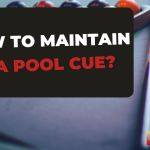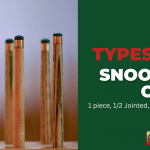Many snooker players can sometimes neglect taking care of their cues. Snooker cue maintenance is a vital part of your routine to keep your cues in a good shape. Your snooker cue can easily last you three to five years of regular play if you take proper care of it.
It is crucial to managing your cues properly as it will guarantee that your in-game precision stays consistent. Taking proper maintenance of your cues will also get you the most out of your purchase. If you are wondering how to maintain a snooker cue, we have compiled a list of steps that you can follow.
7 Steps For Maintaining Your Snooker Cue
Table of Contents
1. Keep Your Cue Clean
The most important step in cue maintenance is how to clean a snooker cue. For proper maintenance, you have to give your cues a regular wipe. The shaft of a high-performance cue is the most expensive thing. Whether it be a predator cue or a carbon fiber cue, the snooker cue shaft has to be kept clean. Now cleaning a shaft is much easier than a lot of people may think.
There are a lot of products or a set of products that you can buy for cleaning your cues. You can also use wipes for cleaning your cues. But in reality, a paper towel and alcohol are enough for proper cleaning of your cue. Just rub alcohol with a paper towel on your cue every time you use it, and that will be enough for cleaning your cues.
2. Avoid Dramatic Temperature Changes
Another important thing in snooker cue maintenance is to protect your cues from drastic temperature changes. Don’t just keep your cues in your car trunk, where the temperature may be hugely different from the outside.
The drastic temperature change may not be good for the cue’s wood. Buy a good quality insulating bag and store your favorite and high values cues in them. The good quality bags will provide good insulation and protect your cues from temperature changes.
3. Use Joint Protectors
Many people don’t know about joint protectors, but these are very important for your snooker cue maintenance. When you put your cue in the bag, the pin of joints may collide with the bag. This can result in damaging the joints; joint protectors can prevent this from happening and protect your cues.
You can easily find joint protectors online or from any supply store and they are also not too expensive. Some expensive cues also come with joint protectors. These joint protectors come in a variety of colors. You may purchase these joint protectors in several colors to color-code your shafts. Some joint protectors even include a scuffer on one side for your cues.
4. Avoid Using Sandpapers
Sandpaper should not be used on a cue as this will remove the protecting sealant from the shaft. Additionally, sanding causes the snooker cue shaft to slowly degrade. If you use sandpaper to clean your cues, you may often void the warranty. If your cue is too rough to be cleaned with a wipe or paper towel, go to an expert to condition your shafts.
5. Get A Quality Tip
You have to be careful while buying a new tip on snooker cue. Don’t go looking for cheap tips, as it may ruin your expensive cues. The prices of best snooker cue tips range from $2 to $30. A good quality tip should last you for a while if you play regularly. If you have a cheap cue tip, you need to immediately go and change them for good-quality ones.
Multi-layered tips are more famous and in demand as they are consistent even after scuffing. They retain the same material, density, and grip throughout the tip life. Cheap tips especially the ones that are not multilayered also lose consistency after some time.
6. Avoid Getting Your Cue Dirty
Whenever you clean your snooker cue shaft, you will notice that the towel or wipes will turn blue. Even if the cue isn’t visibly dirty, it will have chalk and dirt on it. If you want your cue to remain clean, you need to make sure that your hands, grip and the table is clean.
To have as minimal of an impact on your cue as possible, you can wear gloves when playing. You never know when you’ll be playing in a hot or humid environment, so always have a glove on hand. Gloves help stop the sweat on your hands from getting on the cue.
You should also not let the cues lie flat on the table. If the table is dirty, your cues will also get dirty. You can put your cues on the edge of the table so it doesn’t lie flat on the table. Also, wipe the cues after every match with a paper towel so the dirt doesn’t remain on your cues.
7. Store Them in A Proper Place
Another important thing in snooker cue maintenance is to not leave your cues standing over or leaning against the wall. Improperly storing your cues can cause them damage. Every cue hall that you will go to will have someplace to hold or keep your cues. So, keep your cues in a cue rack or a specially designed case.
You should also never let your cue leave out overnight. Make sure to wipe your cues before putting them away, so that the dirt doesn’t go to wherever you are putting your cues at. Always, put away your cues in a proper holder, place, or bag.
Final Words
Give your cue a thorough cleaning after you’ve finished playing for the day. Inspect the parts again, and make any necessary modifications right away. The cue needs to be kept under constant moisture and temperature conditions. Avoid leaving your car in extreme temperatures or resting against a wall.
Check the cue’s joints for cleanliness. The dirt and dust in the joints can accumulate quickly and damage your cues. Always keep your cue in a high-quality case. Don’t use sandpaper on your cues as this will destroy the cue’s finish and wear away the shaft.
Always keep your hands and cues clean. If you follow all the right snooker cue maintenance steps, your cue should endure many games and years with you.












